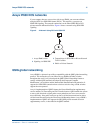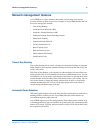
Main/Satellite/Tributary
93
Overview for Avaya IP600 Internet Protocol Communications Server
555-233-001 — Issue 5 — November 2000
11
Main/Satellite/Tributary
If you have modest network requirements, a main/satellite/tributary configuration is
an attractive possibility for private networking. In this configuration, one Avaya
IP600 location is the main, and remote switches are satellites or tributaries. Attendant
positions and public network facilities are usually concentrated at the main.
All calls to or from a satellite pass through the switch at the main. The system appears
to be a single switch with one listed directory number. A uniform dial plan provides a
common 4-digit or 5-digit dial plan for a main/satellite configuration.
A tributary is similar to a satellite, but it has one or more attendant positions and its
own listed directory number. Calls to its listed directory number go directly to the
tributary.
The switches in a main/satellite/tributary network are connected by tie trunks. Trunks
and switching facilities can be added as requirements grow.
An important Avaya IP600 networking feature is Main/Satellite Extended Trunk
Access. Extended Trunk Access allows dialed digits that are undefined at a satellite or
tributary switch to be routed over a trunk group to a main switch for interpretation.
This flexibility means changes to the network numbering plan do not have to be
propagated to all switches. Extended Trunk Access improves your control and
reduces administration costs by making trunk networks considerably easier to
maintain.


















